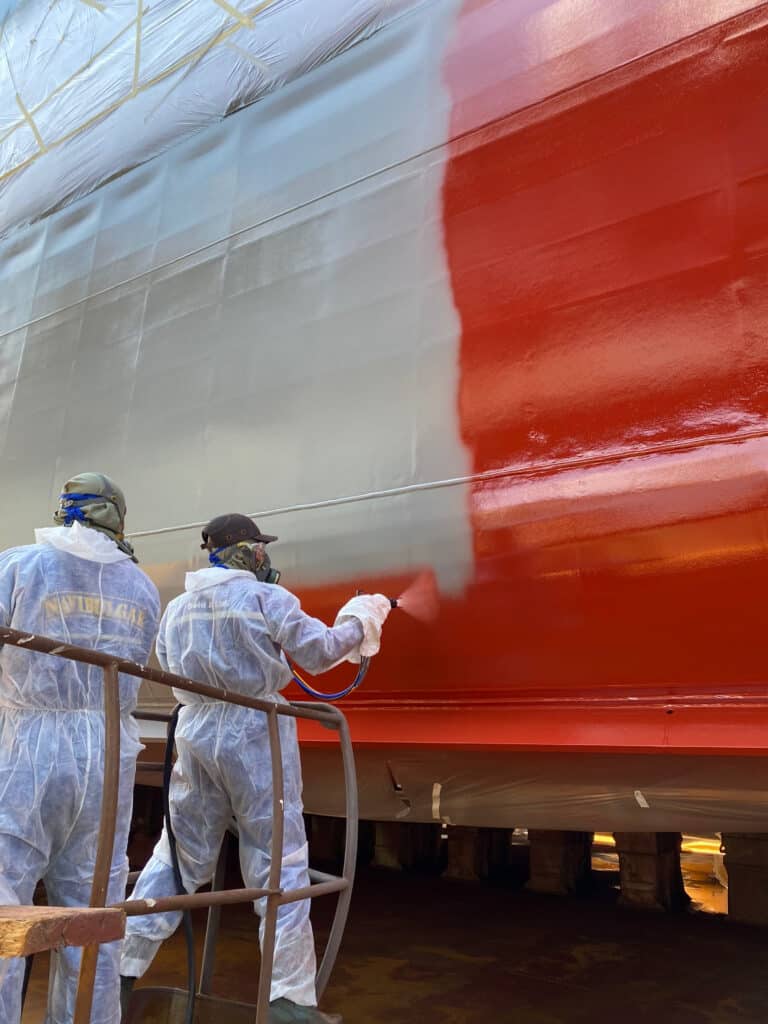Enhancing sustainability through electrostatic coatings
ForestWave Navigation, a progressive shipping company established in 2011, recently embarked on a project that showcases the potential of innovative coating technologies and application methods to significantly enhance vessel sustainability. This case study focuses on the application of PPG SigmaGlide 2390 to the Trito Navigator, a general cargo vessel, using electrostatic application techniques.
ForestWave has rapidly grown to manage a fleet of 35 ships, primarily operating in European waters and the Atlantic Basin. The company’s commitment to environmental stewardship led it to seek a hull coating solution that would reduce power consumption and carbon emissions, without the release of biocides into marine ecosystems.
The challenge was multifaceted: find a coating that could deliver superior performance in terms of power savings, fuel efficiency and emissions reduction, while also utilising an application method that minimised environmental impact during the coating process itself. This is where the PPG SigmaGlide 2390 system, applied via electrostatic spraying, proved to be the ideal solution.
PPG SigmaGlide 2390 is a silicone-based, biocide-free fouling release coating that incorporates PPG’s innovative HydroReset technology. This technology creates an ultra-smooth hull surface with lower friction resistance, potentially reducing carbon emissions by up to 35%. The coating’s ability to maintain its performance over time, with up to 150 days of idle time protection, addresses the growing need for solutions that can adapt to changing shipping patterns and increased port times.
However, the environmental benefits of PPG SigmaGlide 2390 extend beyond its in-service performance. The coating is designed to be compatible with electrostatic application methods, which represent a significant leap forward in sustainable coating practices. Electrostatic application works by negatively charging paint particles as they are sprayed, which and are then attracted to the positive (grounded) hull surface.

The application of PPG SigmaGlide 2390 to the Trito Navigator using electrostatic techniques
The sustainability advantages of electrostatic application in comparison to traditional airless application are numerous and impactful:
- Increased transfer efficiency: Electrostatic spraying substantially improves the transfer efficiency of the coating process. Traditional airless spraying methods can result in significant overspray, with a considerable percentage of the coating not reaching the intended surface. Electrostatic application can achieve much higher transfer efficiencies, meaning more of the coating ends up on the hull where it’s needed.
- Reduced material consumption: The higher transfer efficiency directly translates to reduced paint consumption. In the case of the Trito Navigator, ForestWave reported a noticeable15-20% reduction in material consumed.
- Improved worker safety: The reduction in overspray combined with the low VOC emissions of PPG SigmaGlide provide a much cleaner operation and an improved work environment for the applicators.
- Waste reduction: Less overspray means less waste generated during the coating process. You only have to look at the dock floors at the end of the project to see how much paint has been saved from disappearing into the environment. This reduces the environmental impact associated with waste disposal and cleaning processes in the shipyard.
- Saving time and costs: Electrostatic application can often be completed more efficiently than traditional methods. Due to the reduction in overspray and a cleaner operation, shipyards spend less time masking the vessel and covering the dock, saving valuable time and costs.
- Enhanced coating performance: The paint particles are precisely guided towards the grounded surface of the vessel, leading to an exceptionally even particle distribution and the formation of a uniform and smooth film. This improved coverage and smoothness can enhance the longevity and performance of the coating.
The application of PPG SigmaGlide 2390 to the Trito Navigator took place at the Odessos shipyard in Varna, Bulgaria. The process involved blasting the hull to prepare the surface, applying PPG SigmaPrime as a base coat, followed by PPG SigmaGlide 790 as a tie coat, and finally the SigmaGlide 2390 as the top coat. The use of electrostatic application for the SigmaGlide layers ensured that the environmental benefits began right from the application stage.
The results of this innovative coating and application approach are expected to be significant. ForestWave anticipates that with PPG SigmaGlide on its hull, the Trito Navigator will be able to operate at an average of one knot higher speed, while remaining with a compliant Carbon Intensity Indicator (CII) rating. This improved performance is projected to contribute substantially to ForestWave’s plans for meeting IMO greenhouse gas emission reduction targets over the next decade.
In conclusion, the case of the Trito Navigator illustrates how the combination of advanced coating technology and innovative application methods can yield substantial sustainability benefits. Electrostatic application of PPG SigmaGlide not only enhances the coating’s inherent environmental advantages but also introduces a new level of sustainability to the application process itself. As the shipping industry continues to navigate the challenges of environmental regulation and sustainability expectations, PPG SigmaGlide will likely play an increasingly crucial role in shaping the future of marine coatings and vessel maintenance.
More articles like this can be found in the latest issue of Protective Coatings Expert

